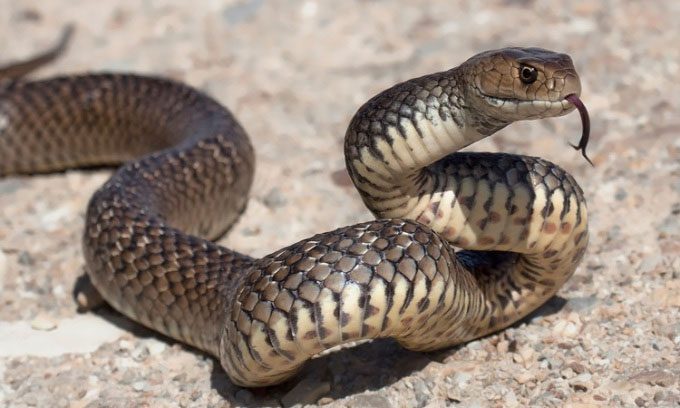The suitable ecosystem and random events have made Australia a promised land for animals that use biological weapons, such as venom.

Eastern brown snake (Pseudonaja textilis) hunts using both venom and constriction. (Photo: Kristian Bell)
Australia is home to countless venomous creatures, including spiders, snakes, jellyfish, octopuses, ants, bees, and even the platypus. Australia became an isolated land approximately 100 million years ago when it broke away from the supercontinent Gondwana, according to Kevin Arbuckle, an associate professor of evolutionary science at Swansea University, UK. Some venomous creatures simply became trapped in Australia when it turned into a secluded land, reports Live Science.
Many venomous arthropods, such as the trap-jaw ant (genus Odontomachus), can deliver a painful bite, but they also inhabit tropical and subtropical regions around the world, not just Australia. Similarly, the Australian bulldog ant (genus Myrmecia), capable of both stinging and biting, is among the most dangerous ants globally and has killed three people since 1936, according to the Guinness World Records. These venomous ants existed in Gondwana at the time of the split and continued to thrive in Australia as it became a separate continent.
As for spiders, the funnel-web spider (genera Hadronyche and Atrax) is a species endemic to Australia that can kill a person with a venomous bite, according to Arbuckle. The male Sydney funnel-web spider (Atrax robustus) once caused 13 fatalities, although no deaths have been recorded since the antivenom was introduced in 1981, according to the Australian Museum. Another venomous spider, the redback spider (Latrodectus hasselti), can also be lethal. Their ancestors were present in Australia at the time of the continent’s separation.
Similarly, venomous cephalopods, including squids, octopuses, and cuttlefish, have existed for 300 million years. They have inhabited the surrounding seas long before Australia separated from Gondwana.
Another reason Australia is filled with highly venomous creatures dates back to 60 million years ago as a “random incident in history”, according to Michael Lee, a professor of evolutionary biology at the South Australian Museum and Flinders University. Back then, the process of continental drift pushed Australia toward the freezing South Pole, wiping out most reptiles. As the continent slowly drifted north, it warmed up and attracted reptiles once again. Coincidentally, 40 million years after this “incident,” the first snakes invaded the continent, descending from venomous cobra relatives, including cobras, mambas, coral snakes, and taipans. They became the ancestors of snakes in Australia, evolving into many more venomous species.
Of the 220 snake species in Australia, 145 are venomous. The deadly dangerous snakes make up 65% of the total snake population there, even though only about 15% of snakes worldwide are venomous.
For jellyfish, all species are venomous. They date back over 500 million years and have floated through oceans long before Australia existed. While box jellyfish (Carukia barnesi) and Portuguese man o’ war (Physalia physalis) inhabit Australian waters, Arbuckle emphasizes that they also exist in other tropical and subtropical seas. They are not phenomena unique to Australia. Instead, the coastal regions of Australia have ecosystems suitable for them.


















































